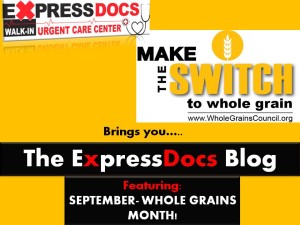September is Whole Grains Month! For good reason, the Whole Grains Council has determined their 2014 theme to be “Make the Switch to Whole Grain”. Whether uninformed, or too busy, many individuals do not incorporate whole grains into their diets. This lack of whole grain consumption could be a contributor to the high obesity rates in children and adults in the United States. If households begin eating less and less refined grains and replace those with more natural whole grains, they will succeed in living longer healthier lives.
Start small.
Swap out one ingredient in your tried and true recipes for a whole grain. Gradually increase your whole grain intake in your diet….You will see and feel the results of this healthier lifestyle. For example, try making barley and meatballs instead of spaghetti and meatballs. Substitute an enriched white flour for a whole grain wheat flour.
Check out the Whole Grains Council website for recipes with ways to “Make the Switch”!
Whole grains are significantly more nutritious than refined grains, which are stripped of their nutrients. Amaranth, Oats, and Brown rice offer more then 50% of the recommended daily intake of Manganese. Quinoa alone offers more than 20% of nutrients such as Magnesium, Phosphorous, Manganese, and Folic Acid! (Whole Grains Council)
Do you know what foods are considered whole grains? If not, continue reading!
Whole Grains include, but are not limited to:
- Amaranth
- Barley
- Buckwheat
- Corn, including whole cornmeal and popcorn
- Millet
- Oats, including oatmeal
- Quinoa
- Rice, both brown rice and colored rice
- Rye
- Sorghum (also called milo)
- Teff
- Triticale
- Wheat, including varieties such as spelt, emmer, farro, einkorn, Kamut®, durum and forms such asbulgur, cracked wheat and wheatberries
- Wild rice
Source: Whole Grains Council

